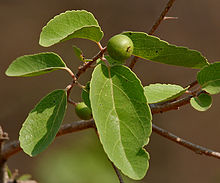Flacourtiaceae
It was so vaguely defined that hardly anything seemed out of place there and it became a dumping ground for odd and anomalous genera, gradually making the family even more heterogeneous.
[1] In 1975, Hermann Sleumer noted that "Flacourtiaceae as a family is a fiction; only the tribes are homogeneous.
"[2] In Cronquist's classification, the Flacourtiaceae included 79–89 genera and 800–1000 species.
[3] Of these, many, including the type genus Flacourtia, have now been transferred to the Salicaceae in the molecular phylogeny-based classification, known as the APG IV system, established by the Angiosperm Phylogeny Group.
Some taxonomists further divide the Salicaceae sensu lato into three families: Salicaceae sensu stricto, Scyphostegiaceae, and Samydaceae,[4] or into three subfamilies.
